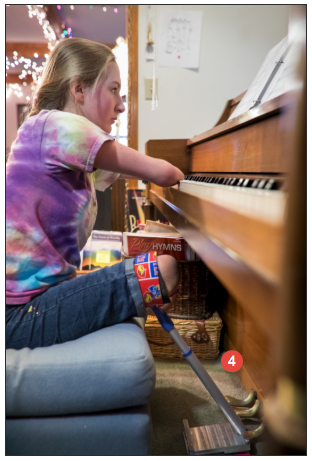KU engineers develop device to foster teen’s music dreams
LAWRENCE — Heidi Burke, a congenital quadrilateral amputee, loves to play piano. Her legs end at the knees and her arms at the elbow, but that has never stopped her from taking lessons and learning to play her family’s upright. There has been just one real obstacle: She was unable to reach the pedals on the instrument, and that left the songs she played sounding thin and tinny.
 “I could play whatever piece I wanted,” she said recently at her Shawnee home on the eve of her 14th birthday. “But it wouldn’t sound good, because it just wasn't like it was supposed to play.”
“I could play whatever piece I wanted,” she said recently at her Shawnee home on the eve of her 14th birthday. “But it wouldn’t sound good, because it just wasn't like it was supposed to play.”
Thanks to a team of student volunteers from the University of Kansas School of Engineering, that’s no longer a problem. Last Christmas, after two years of study, testing and design, the students presented Heidi with a custom-built device that lets her reach and operate the floor pedals on the piano — and play songs to her fullest capabilities.
“All of a sudden,” she said, “I can make it sound like I'm playing all of the notes.”
Heidi’s story has several elements: Her mom’s determination, the existence of a KU program designed to help individuals with disabilities, and Heidi’s own refusal to accept limits. The tale begins in 2015 when Heidi, after taking piano lessons for several years, grew frustrated with her inability to use the floor pedals.
“We were trying to figure out how we could get her to play,” said her mom, Dawn. “I was going to go up there with her and push the pedal. But we just couldn't figure it out, so I thought: ‘Hey, engineers are intelligent people.’”
Dawn Burke called around to several Kansas City-area universities before discovering KU Engineering’s BREAK Program. “BREAK” stands for Biomechanical Rehabilitation Engineering Advancement in Kansas. It is funded with a six-year grant from the National Science Foundation and provides customized design services to individuals with disabilities. Engineering seniors have participated in design-build process as part of their capstone project.
“This one came along at a little bit of a different time frame and probably a little bit smaller scope than most of our projects,” said Ken Fischer, professor of mechanical engineering and bioengineering, who oversees the KU BREAK Program. “So we enlisted the help of engineering students in KU’s Biomedical Engineering Society (BMES) who volunteered to actually work on this project.”
Kelsey Ling, a 2017 graduate in chemical engineering from Overland Park, was then serving as president of KU’s BMES chapter. She led the volunteer team that would spend much of the next two years working with Heidi, brainstorming ideas, testing those ideas, then starting all over again.
“This is why I studied what I've studied,” said Ling. “Stuff like this is really where my passion lies, helping people achieve things that otherwise they wouldn't necessarily be able to.”
What the team found: a young girl who didn’t seem much hindered by her lack of limbs.
 “Heidi walks on her knees, and she can do cartwheels, run, skip, get up and downstairs on her own,” Dawn wrote in a 2015 letter to the team. “She writes, sews, types, plays the piano, eats with silverware, uses scissors, bakes cookies on her own, plays the trumpet, just about anything. She does this by using both of her elbows to grasp things.”
“Heidi walks on her knees, and she can do cartwheels, run, skip, get up and downstairs on her own,” Dawn wrote in a 2015 letter to the team. “She writes, sews, types, plays the piano, eats with silverware, uses scissors, bakes cookies on her own, plays the trumpet, just about anything. She does this by using both of her elbows to grasp things.”
“She's kind of a unique case,” Dawn said of her daughter. “She's very capable without prosthetics, and with them she's less capable.”
The piano pedals proved an exception, however. The student team held several sessions with Heidi, watching her play piano and asking questions. Then they started generating ideas for a pedal pusher.
“We just sat down and had multiple different ideas and prototypes,” said Grant Sacco, a senior in mechanical engineering from Chicago who served on the team. “We had several things we were interested in — mobility, whether she could move around to different pianos. Another one: As she got older, could she adjust it to different heights?”
The eventual result: A telescoping rod with a band at one end to slip around Heidi’s thigh and an aluminum foot at the bottom to directly press the pedal. The team presented it to her at Christmas 2017.
“It was a good Christmas present,” Dawn Burke said.
It was also a good learning experience for the students.
“I think a lot of people don't see engineering as a helping profession,” said Fischer. “When you help some individuals or a group of people, that makes it real.”
“One of my goals in becoming an engineer was to help people,” added Sacco. “It was good to be able to help her, and to learn from this experience.”
Heidi, meanwhile, has big plans. "I'm hoping to be able to kind of play more and more advanced songs,” she said, “and maybe, at my school, accompany the choir."
Her ability to make such dreams come true — thanks to the help of KU Engineering students — has thrilled her family.
“Oh my goodness, my child can play a pedal now,” Dawn Burke said. “I am so grateful because there's no way I could have built anything like that.”